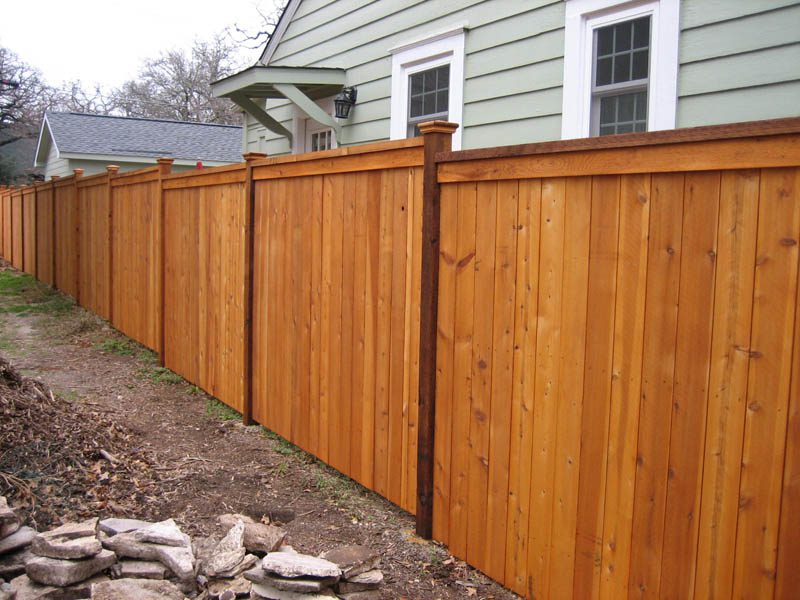Are you thinking about mixing up your home style or updating the exterior? Keep in mind these benefits as you decide whether or not to stain your fence.
Painting Vs. Staining
Consider the following when deciding to paint or stain your fence. Wood materials absorb stain much deeper than paint. Paint will chip and peel while stains only fade over time. Cedar is a particularly popular choice for many wood fences in Austin because it’s less prone to warping. However, painting a cedar privacy fence is counterproductive as the paint doesn’t mesh with cedar. A thick coat of paint does not allow the cedar to breathe and can cause peeling or even reduce how long your fence lasts. This is why we recommend staining over painting for wood fences.
You may also be surprised to know with staining you are not limited by the natural color of your fence material. There are stains in a variety of colors including even indigo, peach, and yellow. However, if you do just want to bring out the natural beauty of a wood material there are stains that will let your wood take center stage.
Cost wise compared to painting, you won’t have to re-stain your fence anywhere near as often as painting it.
Staining Acts as Protection
Staining your fence will provide an additional layer of protection against wood warping due to moisture and heat. It also helps to fend off rot, insects, and other major wear and tear, giving your fence a natural beauty and a longer shelf life. For most wood types, we need to reapply stain once every 3 to 5 years and add sealing every 2-3 years for color retention. Keep in mind climate and the type of wood might requiring staining more often.
When to Stain a New Fence
Staining a fence too early will trap moisture in the wood, but waiting too long will leave it vulnerable to weathering and UV damage. We recommend waiting 4-6 weeks after installation to allow the wood to dry and acclimate, especially when using pressure-treated wood, which often contains moisture from how it’s treated. Waiting this amount of time lets the wood to receive the right amount of moisture to absorb the stain evenly, ensuring a longer-lasting and more effective protective layer.
for most wood types, re-staining every 2-3 years is ideal to maintain a fresh look and strong protection, though specific factors like climate and wood type may influence this.
Tips for Applying Stain to Your Fence
Staining your fence correctly can make a big difference in its longevity and appearance. We recommend getting yourself a sprayer, brush, or roller to help apply the stain and ensure it’s applied evenly.
The first step is to prepare for staining, by cleaning your fence thoroughly and removing dirt and debris, then sanding rough spots to create a smooth surface for the stain to adhere. Then use a sprayer to save time and ensure an even coat for larger fence sections. For smaller, hard-to-reach areas, use a brush or roller to reach these spots. Look to apply staging on days with mild, dry weather when temperatures are between 50 and 80°F —avoid hot days and direct sunlight, which can cause the stain to dry too quickly and not absorb fully into the wood. Use painter’s tape and drop cloths to protect nearby surfaces.
Stains typically dry within 24-48 hours, but drying time may vary based on stain type and weather conditions, so be sure to check product labels.
Taking these steps will help you achieve a smooth, long-lasting finish that shields your fence from the elements.
Best Stains for Your Fence
Choosing the right stain can help protect your fence and keep its appearance up for years. Depending on your desired finish, you can choose from semi-transparent stains to highlight the wood grain, solid stains for full-color coverage, or transparent stains for a natural look with minimal color. Here are some of our favorite fence stains:
- Overall Best Fence Stain: Ready Seal Exterior Wood Stain and Sealer combines a rich, natural finish with strong protective qualities. It’s easy to apply, dries quickly, and doesn’t require a primer. Ready Seal also resists mold and mildew, keeping your fence looking great longer.
- Best Stain for Your Dollar: Krylon Exterior Semi-Transparent Wood Stain provides excellent value. This semi-transparent option comes in an easy-to-use spray can, making it easy to apply. It offers solid protection at an affordable price, perfect for those on a budget.
- Best for New Fences: Storm System Protector Stain & Sealer is designed for new fences. Its formula penetrates deep to protect against moisture and UV rays.
- Other Notable Options:
- Seal-Once Nano+Poly Premium Wood Sealer: Ideal for restoring older fences, this sealer helps revitalize wood while adding a protective barrier against further damage.
- Olympic Maximum Wood Stain and Sealant: This 2-in-1 stain and sealer combo is convenient and practical for those applying just one product.
- Cabot Australian Timber Oil Wood Stain and Protector: Known for its beautiful, natural finish, this oil-based stain protects well against UV rays and moisture, ideal for areas with a lot of sun.
- SaverSystems #1 Deck Premium Wood Stain: This low-VOC, water-based stain is an eco-friendly option that’s easy to clean up.
- Defy Extreme Semi-Transparent Wood Stain: This stain is strong against mildew and UV protection, so it works well in humid environments where durability is essential.
Residential and Commercial Fence Staining
Covering Austin, Round Rock, Cedar Park, Leander, Pflugerville, and more, we build residential and commercial fences throughout the region. We also serve Dripping Springs, Kyle, and several other nearby areas.
Looking to have your fence stained or re-stained? Contact our fence company today!
